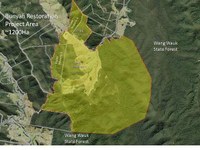Bunyah Restoration Project
Restoring Habitat and Connectivity to assist Koala Population in Bunyah
The Bunyah Restoration Project consists of 4 Private Landholdings located adjacent to the Wang Wauk State Forest on the Mid North Coast of NSW. Our group primarily aims to protect the areas koala population while demonstrating how farming and conservation can be mutually beneficial. We aim to do this by planting over 12km of shelter belts/wildlife corridors along our Riparian zones and installing “Blinky Bill” style koala waterers. To understand our impacts and inform future decisions we have partnered with the University of Newcastle, who will assess the population density and Chlamydia status of our koala population. These population assessments will provide critical baseline data on likely koala prevalence and sustainability in a known koala population that has previously not been assessed. Once collated, this data will be critical in informing regional conservation plans as well as local forestry, tree planting and local development guidelines.
We believe that farming and conservation are mutually beneficial. Our proposed plantings of 18000 trees along our denuded riparian areas will provide koala food trees and wildlife corridors linking the forested areas on either side of our grazing area. Additionally, these plantings will establish important shelter belts for our property and improve water quality, both of which will improve agricultural productivity. Secondary benefits will be a reduction of average paddock size and improved watering options.
Our groups collection of private landholdings consist of 385Ha, made up of 160 Ha of cleared grazing land with the remainder made up of open native hardwood forests. The cleared land is used for cattle grazing via regenerative farming, nursery enterprises and nut production whereas the forested areas are used for periodic grazing, forestry and undisturbed native habitat. The area has a viable and well established koala population that was fortunate to escape the recent (2019/20) fires. This view is supported by local landholders with koala sightings a common but sadly decreasing occurrence. Notably, the Bunyah area is not recorded as having a high density of koalas, however, the southern portions of the Mid North Coast are poorly studied and the works detailed in this Project will partly address this shortfall.
For more information or to get involved, please contact Shaun Tamplin at trexshaun@gmail.com





